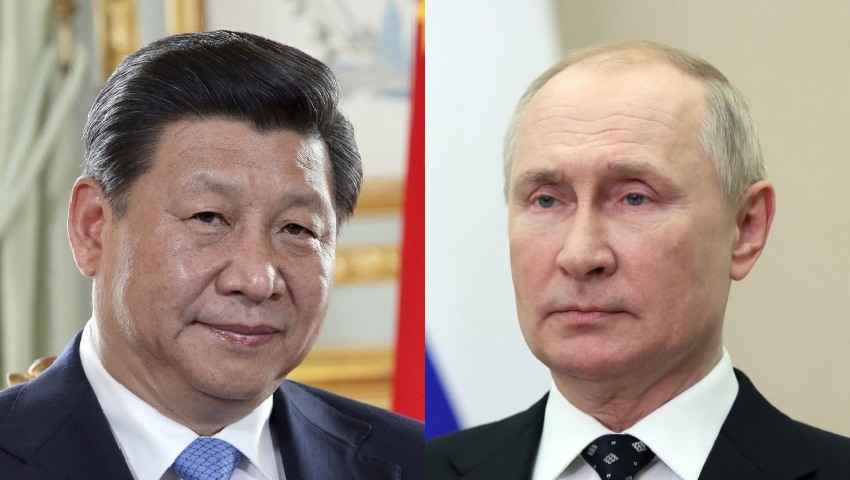The invasion of Ukraine has called Russia’s military technology and doctrine into question. What lessons will the Chinese People’s Liberation Army glean from the bungled invasion? And how will these change Chinese military capabilities?
To continue reading the rest of this article, please log in.
Create free account to get unlimited news articles and more!
“A new model of cooperation has been formed between our countries, based, among other things, on such principles as non-interference in internal affairs, respect for each other’s interests, and determination to turn our common border into a ‘belt’ of eternal peace and good neighbourliness,” Russian President Vladimir Putin said during a video call with China’s Xi Jinping earlier in the year.
The call was off the back of a growing military and political relationship between the two nations.
In August 2021, Russia and China commenced a joint military drill in China’s Ningxia region which included 10,000 military personnel, Su-30SM aircraft and air defence systems.
Not long after, in October, both nations held the Joint Sea 2021 naval exercise off the Russian coast focusing on mine, air and underwater operations.
Though perhaps the greatest asset to China of this burgeoning security relationship has been Russia’s hard-learned lessons during the invasion of Ukraine.
According to former US Army Officer and director for China & Indo-Pacific Security Affairs at CNA David Finkelstein in War on the Rocks this week, Russia’s military failures are likely to spur doctrinal modification within the People’s Liberation Army to avoid the same mistakes.
“In 2016, the PLA underwent the most sweeping reorganization in its history in an attempt to better position itself to be able to fight modern information-age warfare,” Finkelstein contends.
Within the modernisation were elements of Russia’s 2008 “New Look” military reforms that were launched following the successful invasion of Georgia that same year. Though, the reforms which were aimed at developing a streamlined and more professional Russian military have yet to yield widespread wins on the Ukrainian battlefield.
The analyst further contends that the invasion has given the PLA the opportunity to learn lessons on how to bridge the gap between military training and implementation of military doctrine on the battlefield.
“Russia’s performance in Ukraine will provide the PLA with a sense of the difference between training and actual combat. This issue is of great importance for the PLA, which is all too aware of the fact that it has not seen large-scale combat since it invaded Vietnam in 1979,” he continued.
“One lesson they may draw is that even for militaries with extensive experience, war remains a difficult business.”
These fundamental Russian mistakes include poor logistical support and hubris, which the analyst contends violate the PLA’s “Basic Campaign Principles”.
Worryingly, Finkelstein notes that the war gives insight to Chinese military planners about Russian military technology – including “their strengths and vulnerabilities” – of which China still has exposure.
Such poor military technology is of no surprise to many.
In February, many questioned whether Russia would invade at all as it would signal to the world that (despite the bluster) Russia actually possesses substandard military technology, and that Ukraine’s irregular warfare capabilities would create a sustained insurgency that would simply be intolerable for the Russian government.
In early March, online sleuths took to social media to argue that a combination of poor vehicle maintenance and badly made Chinese tyres had stalled Russia’s advance to Kyiv, forcing military vehicles off of muddy fields and onto roads. This had the result of Russian-tank-induced traffic jams on major Ukrainian highways.
Not only do the failures of Russian military technology evidence the need for Chinese decision-makers to potentially decouple their technology from Russia – but it has also spurred the need for enhancing their joint-arms capabilities.
“As long-time students of Russian doctrine, the PLA will likely be wondering, if not incredulous, about the apparent lack of ‘jointness’ in Russian operations. Moscow’s Ukraine campaign looks very much like ground-force-centric combined arms warfare — the very type of warfare that the PLA is trying to move beyond for major operations,” he continued.
“Instead of demonstrating elegant 21st-century joint operations with high-tech assets — as the U.S. military does and the PLA aspires to be able to do – Russia, the PLA will observe, seems to be reverting to ground, air, and missile attacks employed as blunt instruments.”
Such deficiencies were amplified by Major General (Ret’d) Mick Ryan in early March, who shone a light on the surprising omissions within Russian military strategy.
Throughout a 25-post Twitter explanation, Ryan identified three missing areas in Russia’s military strategy that raises some eyebrows: few (observable) cyber operations, poor Russian command and control structure and a lack of human-machine teaming.
It is week 4 of the Russian invasion of #Ukraine. Today I examine those aspects of the Russian war machine that many expected to see, but we have yet to observe, during the war. 1/25 pic.twitter.com/yN0pdtCBio
— Mick Ryan, AM (@WarintheFuture) March 23, 2022
Indeed, such omissions seem surprising to the former ADF commander given Russian General Valery Gerasimov’s push over the last decade to modernise and reform Russia’s military.
“Gerasimov foresaw Russia developing new and old means of warfare to achieve the aspirations of this new military strategy. What is fascinating, at least to me, is what aspects of their new forms of war we are NOT seeing to a significant degree in their invasion of Ukraine,” the retired ADF commander said.
Despite their bourgeoning security relationship, perhaps Russia’s greatest gift to China is lessons from their failures.
Get involved with the discussion and let us know your thoughts on Australia’s future role and position in the Indo-Pacific region and what you would like to see from Australia's political leaders in terms of partisan and bipartisan agenda setting in the comments section below, or get in touch with

 Login
Login







